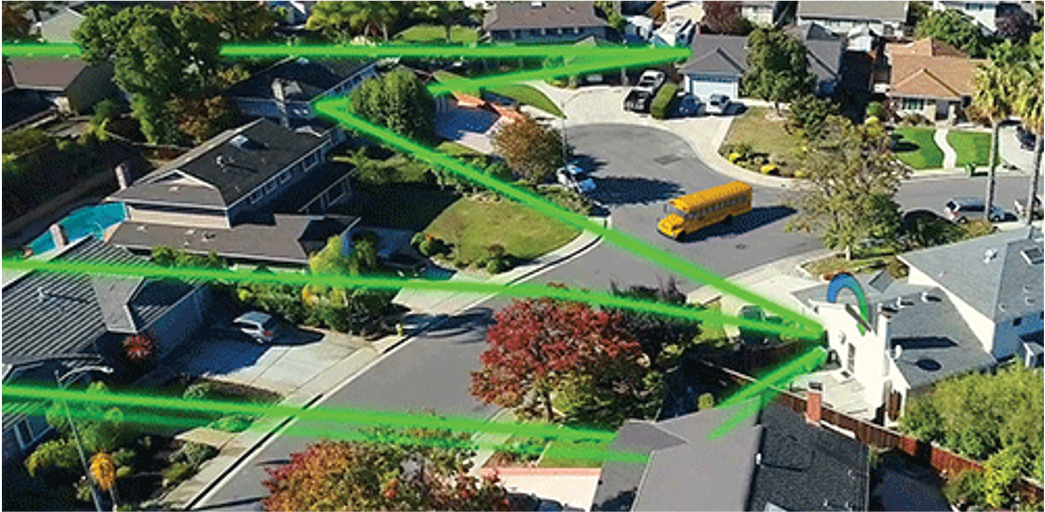A significant challenge for fixed wireless is how to get around obstacles. While things may look great on the tower, chances are good the signal will need to get around or through things like buildings, foliage, moving vehicles, gigantic wildlife, terrain, and so on before reaching the subscriber. Approximately 90% of all links beyond 350 meters from a tower will be obstructed, i.e. non-line of sight (NLoS) rather than line of sight (LoS).
Figure 1: Probability of LoS links over distance
This is a big problem since NLoS propagation dramatically lowers range, link speed, and reliability. Shorter distances decrease the coverage area that a single base station can serve while increasing costs (more base stations needed). Slower link speed impacts what service tiers (at a higher ARPU) can be sold to the customer.
NLoS can also lower reliability due to changing conditions. Reliability (and customer satisfaction) is always an issue for fixed wireless. Unlike mobile networks where you can take your phone somewhere with a stronger, more reliable signal, the same can’t be done with your home if the connection is poor.
Since chopping down trees or moving your neighbor’s house to get rid of obstacles is rarely an option, a good fixed wireless system needs a plan for dealing with NLoS. One option is to move base stations closer to homes in hope of getting a clear line of sight. That’s often not practical; either due to the cost of more base stations or because there simply aren’t enough potential mounting sites available.
Tarana G1 overcomes the negative impact of NLoS links in several ways. It starts with distributed massive multiple-input, multiple-out (DM-MIMO) at the base node (BN) and the remote node (RN). This means each device has an array of antennas that can be used to find the best link paths between them. Think of it like a door with many peepholes. The more peepholes (antennas), the better chance you’ll be able to look through one or more and see the object you are looking for on the other side clearly.
Next is Rx and Tx digital beamforming. With beamforming, the antenna array of the BN and the RN are able to direct RF energy along the best path between them in a directional manner. This increases signal strength and reduces the impact of attenuation or interference. G1 takes beamforming to another level with auto-convergent retro-directive (AC-RD) beamforming. AC-RD is a sophisticated, patented closed loop algorithm where the BN and the RN collaboratively work to converge on the optimal beamforming solution for improved link stability and reliability.
Another enemy of link performance is when a signal is reflected or diffracted such that it takes multiple paths to get from the transmitter to the receiver, otherwise known as multipath. When a link is non-line of sight, multipath is guaranteed. The question is, what is the right path? Or can you combine multiple paths to reconstruct the original signal?
Part of the reason G1 is so good at NLoS is, in fact, how it handles multipath. It does this with a technique we call Space Time Frequency Adaptive Processing. Specifically, STFAP works with AC-RD using the antenna arrays to receive the signal from various angles of arrival, amplitude, phases, and delays to combine multipath signals and recreate the original signal. With STFAP, reconstructing the original signal from the various multipaths can actually result in a stronger link because all available energy can be used. The ability to precisely compute all of this information from multipath lets G1 take advantage of things like reflection and diffraction to bend around objects that would otherwise obstruct the signal.

All of these features together and more are why G1 is so good at achieving stable, reliable, high-speed links at impressive distances for line of sight, near line of sight, or even non-line of sight. With G1, our customers are finding that links that weren’t possible before are now achievable which means a broader customer base without building new towers or installing more base stations.
Or take the word of this subscriber:
“I’ve been trying to get Wisper [my local ISP] to serve me for two years and they always said they couldn’t. Now they can!” – Dale A., Wisper customer
“Throw out the window the way you’ve built wireless in the past and then come back in with a fresh set of eyes.” – Nathan Stooke, CEO, Wisper Internet
If you just can’t wait to learn more, check out our other blogs or some of our favorite customer links. Or reach out to us at info@taranawireless.com. We’d love to hear from you.


